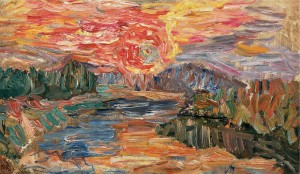In a letter to Nikolai Gay, Leo Tolstoy wrote, “Death is birth. Since we have lived to see the death of learning, this must mean that the birth is at hand …” [8]
Expressionism is the simultaneous realization of both the death and birth of the language of art. It is the artist’s experience of how this language affects him and all of history and his awareness of the present. It is a breaking-off, a denial of the possibility of either death or birth. It is the expectation that permeates culture and liberates the artist from trusting already existing texts about creative works.
Wassily Chekrygin wrote in his diary on January 20, 1921, “As an artist, I know that death is a temporary state. Something similar happens in the life of forms. Some forms disappear from the surface of the work, but nevertheless continue to exist, not only as a factor that predetermines the appearance of later forms, but in a general sense, inside the picture. Then they reemerge in the work’s apex …” [9]
In contrast with the immortality that official culture awaits, expressionism believes in the impossibility of death and agonizingly awaits the birth of a new world, a new person, a new art and a new language. Expressionist culture does not attempt to preserve itself; on the contrary, it tries to go away, to die to official culture in order to be born anew, or more precisely, to finally be born. The artist stands on the brink of immortality and refuses to accept it. At this point, a strange parallel can be drawn to a passage in Bulgakov – “Short, incoherent, unusual thoughts began to pour forth: ‘He’s doomed!’, then ‘We’re doomed!’ But among them was the completely incongruous thought of a necessarily impending immortality (for whom?!), and this immortality for some reason evoked unbearable anguish.” [10]
On the Brink of Eternity. That is the title of an unpublished book of memoirs written by Nikolai Viting, who in 1930 became the youngest participant of the fifth art exhibition held by the artists’ society known as “The Painter’s Guild”. Among his reminiscences of that spring’s events, the author writes, “What unified the artists of the Guild? … their common artistic aspirations. From the outset, the Guild’s artists considered themselves expressionists, Soviet expressionists. This principle unified them and distinguished them from other artists’ circles.” [11]
Do these words mean that expressionism was seen by the young artists who started to paint during the 1920s as one of the living language of contemporary art? Yes. Can they be taken as a testimony to the institutionalization of expressionism? That is, had expressionism become the official idiom of an artists’ society such as the Painter’s Guild? Unfortunately, no.




Капитановский Александр
25 Aug 2012
Встретил Ваши тексты, прежде не довелось. Теперь читаю. С благодарностью и уважением.